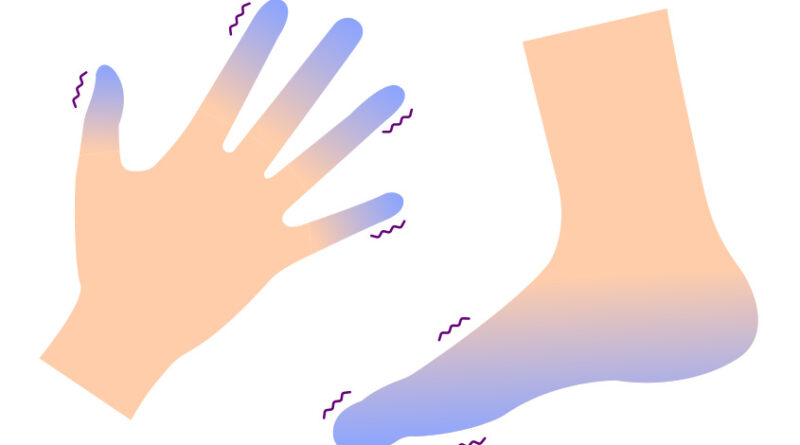Running Cold
Do you always have cold hands or cold feet? It may be Raynaud’s Syndrome
By Deborah Jeanne Sergeant
Although spring is slowly springing, people with Raynaud’s syndrome experience cold extremities year-round.
Everyday activities can cause a flare-up.
The condition affects the extremities as a reaction to pressure, cold temperatures or emotional upset.
Raynaud’s is significant enough to cause the ends of fingers and toes to appear pale and feel completely numb. Some people feel the effects in their ears, nipples, knees or nose.
Raynaud’s happens because the small arteries of the extremities narrow so that less blood flow causes both the lack of color and numbness.
The condition tends to affect women more than men. Raynaud’s affects 5% to 10% of the population and 20% of all women of childbearing age. But only 10% of those affected are aware that their pain and discomfort have a medical explanation.
Ninety percent of Raynaud’s occurs on its own as primary Raynaud’s, but about 10% of the time, it manifests secondarily to an inflammatory condition such as lupus, scleroderma, inflammatory myositis, rheumatoid arthritis or autoimmune thyroid disease. Raynaud’s symptoms are aggravated by caffeine, tobacco use and alcohol.
Work-related injuries can cause Raynaud’s, including using power tools or repetitive impact actions such as typing or playing piano.
Some medications can worsen Raynaud’s, including beta-blockers, chemotherapy, cold remedies, migraine medication containing ergotamine and estrogen-containing medicine.
“So many doctors don’t fully understand it,” said Lynn Wunderman, chairman and founder of The Raynaud’s Association, 501(c)(3) nonprofit organization in Redding, Connecticut. “There is not a formal test for primary Raynaud’s. A doctor has to sit and listen to patients to understand.”
She encourages seeking help from a rheumatologist because many of them see rheumatoid arthritis patients affected by Raynaud’s and can offer advice. Many general practitioners who do not understand Raynaud’s dismiss it by telling patients to “move South” or “wear gloves” but because triggers are more than just exposure to cold weather and the condition is more serious than simply cold hands, these strategies are not enough.
“As the blood rushes out of the extremities, they start turning white,” Wunderman said. “In a few minutes, they turn blue. When we get warm and calm, the blood rushes back quickly and the extremities turn red. It can be very painful.”
Some patients experience a flare up during times of stress. The effect’s mechanism is similar to when people worried about public speaking experience clammy hands facing a large audience. But imagine the fingers going completely numb and pale. Most people’s hands feel a little cold after rummaging in the freezer for that lost bag of frozen peas. Those with Raynaud’s lose circulation in their hands just by picking up glass of ice water, even during the summer. Raynaud’s causes a much more severe response to what is minimal to moderate stimuli for the rest of the population.
Treating Raynaud’s is important for quality of life. Numbness can contribute to injuries. It’s also unpleasant to feel extremely cold and endure the redness and painful, pins-and-needles feeling of circulation returning.
In extreme cases, untreated Raynaud’s can cause skin sores to develop on the affected skin. The lack of circulation can cause death of the tissue and amputation. However, this is very rare, as treatment can prevent this from happening.
Treating Raynaud’s includes avoiding exposure to cold and repetitive activities to prevent triggering a flare-up. Patients should quit smoking, exercise regularly, stay hydrated, manage stress and discuss taking medication that helps reduce blood vessel constriction. It is also vital to manage any related conditions such as lupus or rheumatoid arthritis.
During a flare-up, swinging the arms like a windmill or placing hands under the armpits or under warm water can improve circulation and warmth.
No FDA-approved medications have been indicated for Raynaud’s although a few have been used off-label to help patients, such as calcium channel blockers, which open blood vessels and topical creams. Wunderman encourages patients to discuss medication options with their physicians. Surgical procedures that sever nerves can also offer relief. However, surgery is considered only in the most severe cases.
Strategies such as dressing in layers, avoidance of directly touching cold items and using rechargeable handwarmers helps Wunderman. She selects insulated tumblers or stemware for cold beverages to protect her hands. Gloves and socks with temperature regulating copper or silver can help patients stay warmer.
“I know the second it’s 60 degrees outside, I have to wear boots and gloves,” Wunderman said. “I know better. Once I learned what is going on, I began amassing a whole portfolio of gloves and socks to go with my outfits. People always ask, ‘What are the best gloves?’ but there’s no right answer.”
Some find relief by tapping into the mind–body connection through tai chi, acupuncture, massage therapy and biofeedback to “train your mind to deal with the cold and find relaxation,” Wunderman said.

